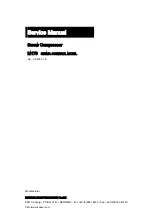
MAINTENANCE & TROUBLESHOOTING
TROUBLE
No start condition
Low pressure
Safety valve releasing
Tank pressure drops
when compressor
shuts off
Excessive moiture
coming out of air hose
POSSIBLE CAUSE
Fuse blown or circuit breaker tripped
Loose electrical connections
Overheated motor
Air leak in safety valve
Defective check valve
Defective pressure switch or
improper adjustment
Loose drain valve
Loose connections at regulator or
pressure switch
Excessive water in the tank
Humidity too high
CORRECTIVE ACTION
Check for cause of blown fuse/breaker and replace
Check wiring connections
Turn compressor off, wait until total cool-down before restarting
Check valve manually by pulling upwards on ring. If condition
persists replace valve
Replace check valve
Check for proper adjustment and if problem persists, replace
pressure switch
Tighten drain valve
Check connections for leaks, seal with Teflon tape
Drain tank through drain valve
Move compressor to area of less humidity. Risk of electric
shock!
TROUBLE SHOOTING
MAINTENANCE
Before doing any maintenance or adjustments to your air compressor, the following safety precautions should be taken:
- Disconnect electrical power.
- Release air tank pressure.
Daily or before each use:
1. Drain condensation from tank.
2. Check for any unusual noise or vibration.
3. Be sure all nuts and bolts are tight.
KEEP TOOL CLEAN
Periodically blow out all air passages with dry compressed air. Clean all plastic parts with a soft damp cloth. NEVER use solvents to clean
plastic parts. They could possibly dissolve or otherwise damage the material.
CAUTION
: Wear safety glasses while using compressed air.
FAILURE TO START
Should your compressor fail to start, check to make sure the prongs on the cord plug are making good contact in the outlet. Also, check
compressor fuse or tripped circuit breakers in the line.

























